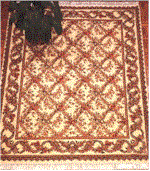

 The Savonnerie rug, aristocrat of rugs of the Western world, was first produced in 1628. The Savonnerie rug has a textured pile, knotted by hand in much the same manner as an Oriental carpet, with a Turkish knot. Savonnerie rugs are usually baronial in size and are better suited to elaborate and formal rooms. Named for a children's hospice in Southern France, in the 17th c. students of Pierre DuPont took control of the hopsice and created a self-supporting factory that flourished through the Revolution and Napoleon. This hand knotted wool rug of gaily colored florals has an antique washed look. Indicate in comments section of the order form the color desired: burgandy, emerald, black, or blue mint. Today the word Savonnerie means a type of style of weave, and rugs woven in this manner can be found to emanate from many other parts of the world.
The Savonnerie rug, aristocrat of rugs of the Western world, was first produced in 1628. The Savonnerie rug has a textured pile, knotted by hand in much the same manner as an Oriental carpet, with a Turkish knot. Savonnerie rugs are usually baronial in size and are better suited to elaborate and formal rooms. Named for a children's hospice in Southern France, in the 17th c. students of Pierre DuPont took control of the hopsice and created a self-supporting factory that flourished through the Revolution and Napoleon. This hand knotted wool rug of gaily colored florals has an antique washed look. Indicate in comments section of the order form the color desired: burgandy, emerald, black, or blue mint. Today the word Savonnerie means a type of style of weave, and rugs woven in this manner can be found to emanate from many other parts of the world.
Savonnerie workshops were founded in Paris and their output of weavings was for royal palaces, state gifts and important commissions. Designs created by court artists included floral arrangements, military and heraldic references and architectural motifs. Warps were made out of linen and the woolen pile was woven using the symmetrical knots. The greatest period of Savonnerie rug production was between 1650 - 1789. Today, most 17th and 18th century Savonnerie rugs are found only in some of the world's greatest museums.
The most important European styles in the history of European rug weaving are the French Savonnerie of the 17th and 18th century, which are still being copied by countries such as India, Pakistan, China and Iran.
Disclaimer: The information provided in this article is for general informational purposes only. While we strive to ensure the accuracy and reliability of the information presented, we make no warranties, express or implied, about the completeness, accuracy, reliability, suitability, or availability with respect to the content. Any reliance you place on such information is strictly at your own risk. We recommend consulting with professionals for specific advice tailored to your project’s needs, particularly regarding building codes, regulations, and product specifications.
Under no circumstances shall we be liable for any loss or damage, including without limitation, indirect or consequential loss or damage, arising from the use of, or reliance on, the information provided in this article.
